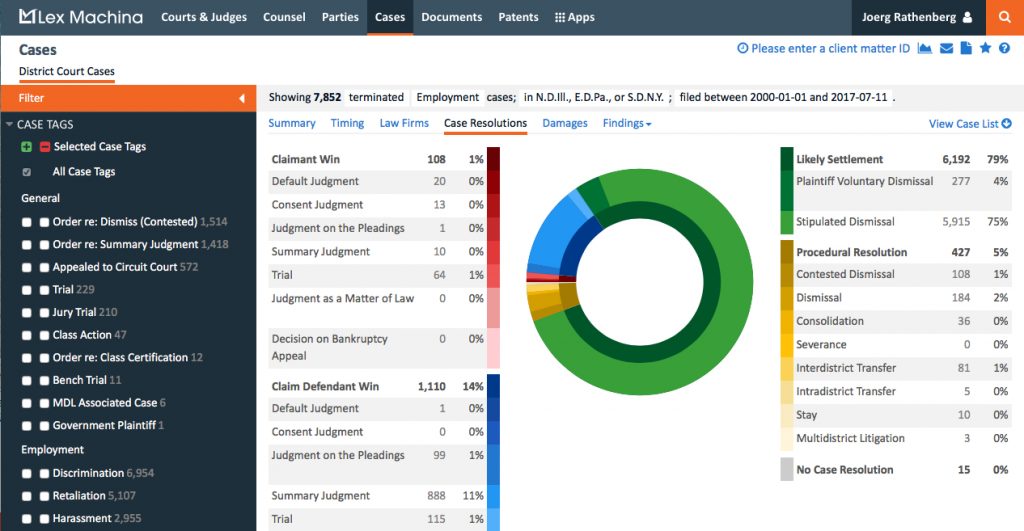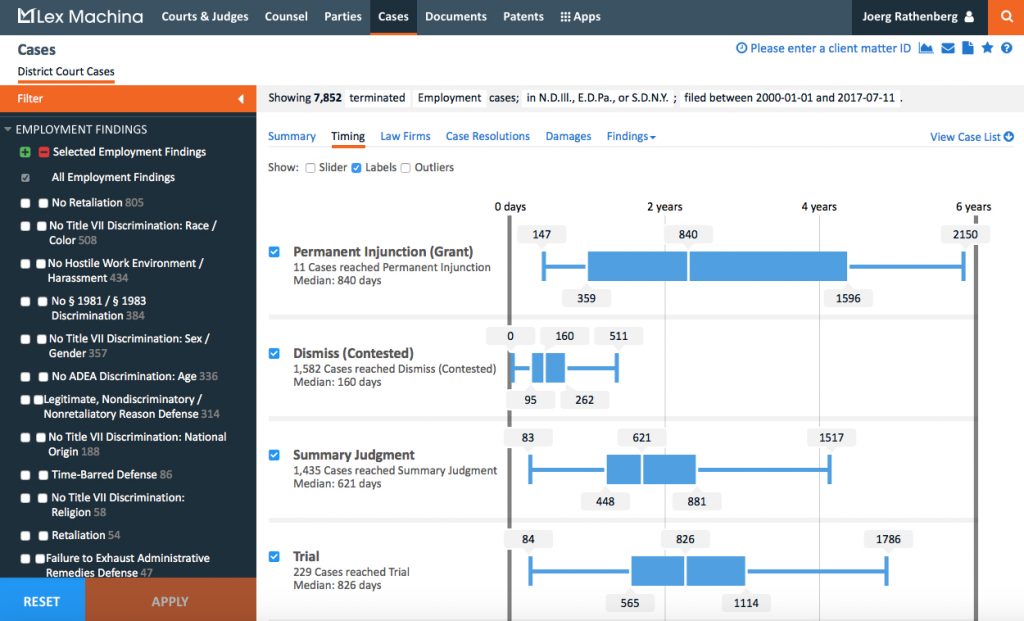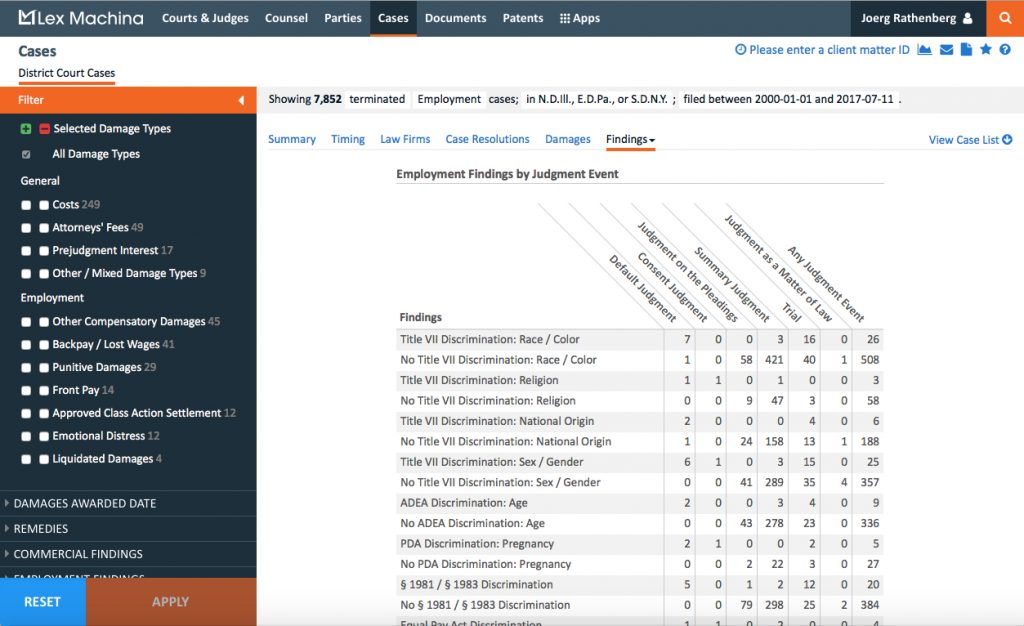When LexisNexis acquired the legal analytics platform Lex Machina in November 2015, the plan was to use LexisNexis’s collection of federal and state docket data to expand Lex Machina’s analytics beyond its original area of intellectual property. Since then, it has been adding practice areas at a regular clip, starting with securities last July, antitrust in November, and commercial litigation last month.
Now comes employment litigation, as Lex Machina today announces an employment litigation module that analyzes data from some 71,000 discrimination, retaliation and harassment cases filed in federal court since 2009. The new module provides the same sorts of analytics as prior modules, offering insights into case timing, resolutions, damages, remedies and findings, as well as information on law firms, parties, judges and venues.
“We decided after the Lexis acquisition that if we wanted to go big we’d have to attack the broad middle of the law,” Owen Byrd, chief evangelist and general counsel at Lex Machina, told me yesterday. “In terms of case count and value to practitioners, we quickly centered on commercial and employment as our first big additions to our offering. Last month, we rolled out commercial. Now rolling out this week is federal employment litigation analytics.”
The module provides analytics for three types of employment cases, those in which an employee is suing an employer for discrimination, retaliation or harassment. In the fall, Lex Machina will add disabilities and labor relations cases to the module.
Next month, Lex Machina will add a module for bankruptcy cases, Byrd said.
While the underlying analytics are the same, each new module requires the addition of subject-specific tags. Lex Machina says it develops these tags by interviewing practitioners in each area of law to better understand their practice area and use cases. The employment module adds tags related to:
- Damages. New tags have been added for back pay/lost wages, emotional distress, front pay, liquidated damages, and punitive damages.
- Findings: New tags have been added for discrimination statues such as Title VII (race/color, religion, national origin, sex/gender), ADEA (age), PDA (pregnancy), §1981/§1983 (equal rights/civil rights violations), USERRA (members of the military), the Equal Pay Act and the Rehabilitation Act. Tags have also been added for hostile work environment/harassment, retaliation, failure to mitigate defense, time barred defense, failure to accommodate, legitimate nondiscriminatory/non-retaliatory reason defense, and failure to exhaust administrative remedies.
- Remedies: New tags related to remedies are notice posting, promotion and reinstatement.
Lex Machina says that the new employment analytics will allow attorneys to answer questions such as:
- How many times have damages for lost wages been awarded in a federal employment case? What were the specific amounts?
- What can you know about a law firm sending a demand letter – how real is the threat?
- Which law firms have the most experience defending Walmart in federal employment cases?
- How often – and in which cases – have judges in the District of Delaware found a hostile work environment?
- What are the chances of obtaining a summary judgment order in an employment case from a specific judge?
In demonstrating the module yesterday, Byrd pointed out some interesting findings revealed by the analytics. One is that the law firms generally perceived to be the three dominant firms representing employers in employment cases truly are. Data shows that the firms with the most employment cases are Littler Mendelson, Ogletree Deakins, and Jackson Lewis.
The data also shows that plaintiffs rarely win in employment litigation. Although the analytics do not reveal the outcomes of cases that settle, for those that go to trial, plaintiffs win in just 1 percent of cases, and on summary judgment, plaintiffs win in only a negligible fraction of cases compared to employers.
With regard to remedies, the analytics show that punitive damages were awarded in only 192 employment cases and attorneys’ fees in just 437 cases.
Some other trends revealed by the data:
- Based on cases filed between Jan. 1, 2009, through June 30, 2017, discrimination lawsuits are by far the most common (87 percent of cases), followed by retaliation (66 percent) and harassment (35 percent).
- Employment cases often involve overlapping kinds of claims. Discrimination and retaliation claims are combined more than half the time, and the other two combinations occur in about a third of cases.
- Cases with all three tags comprise just under a quarter of the cases.
- Top government defendants include local entities such as the City of New York and the Metropolitan Washington Airport Authority, as well as federal organizations such as the U.S. Post Office and Department of Defense.
- Corporations facing the most employment cases include Walmart, Home Depot, Target, United Parcel Service, Bank of America, and United Airlines.
If you are interested in learning more about this new module, Lex Machina is hosting a free webcast tomorrow, July 13, at noon Eastern time to demonstrate its analytics and discuss some of the trends in employment litigation the analytics reveal. The webcast will be moderated by David Lat, founder and managing editor of Above The Law, and will include David Walton, shareholder at Cozen O’Conner; Patrick DiDomenico, chief knowledge officer at Ogletree, Deakins; and Byrd.
 Robert Ambrogi Blog
Robert Ambrogi Blog

